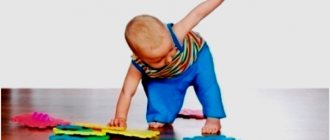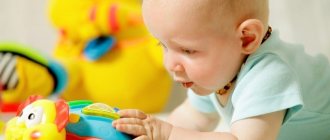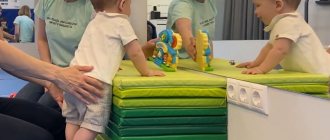Introduction
The first birthday has passed, and your baby is rapidly changing from day to day. From a funny, cute toddler he turns into a restless explorer. After one year, the child enters the age of active knowledge of the world around him, his intellect, emotions, and psyche develop. Now the baby is still pliable, like plasticine. And usually at this age it is not difficult for parents to instill in him the right habits and a healthy routine. Although bright-character children can already begin to show their character.
Physical parameters per year and two months
The WHO standard for 14 months has developed the following indicators:
- Weight – 10-13 kg
- Height 74-82 cm
- Head circumference – 46-48 cm
- Chest circumference – 48-51 cm
Important! Small deviations from the norm are allowed. Don't worry if your baby is a little larger or, conversely, smaller than the surrounding children. Each child develops in different conditions, it is not surprising that each of his features is formed in his own way.
What can a baby do?
At this age, children can already walk without outside support.
Children can also climb stairs themselves, sit down, climb onto low obstacles, such as a sofa or chair, and also descend from them.
Performs simple actions on objects.
He can comb his hair, open/close cabinet doors, and ride a toy horse.
If something doesn’t work out for him, he points to an object and asks for help, skillfully imitates the behavior of his parents, for example, putting something to his ear and “talking on the phone.”
He can also ask relatives to play a specific game with him.
You may notice that at this time the baby is already playing on his own.
Activities for mental development
We develop speech skills:
- Voice all your actions that you perform together with your baby (for example, “take the teddy bear and put it in the box,” “let’s take the pants and put them on the legs,” “hold the spoon and eat the porridge”);
- we give names to parts of the body, performing some actions with them (“let’s wash our palms,” “move our fingers,” “pat our legs”);
- looking at educational books with your child, we describe what is depicted in them;
- learning short nursery rhymes.
We study forms and properties:
- We determine the shape of the object - for example, a ball and a cube. We explain their properties using a clear example - the ball rolls, the cube is suitable for building a tower.
- We show the properties of materials and objects: pour water, crumple or tear paper, close and open the lids of boxes or pans. When working with your child, pay attention to safety. The baby will still be able to taste it, and he is also teething.
- Let's start drawing. Give your child paints, pencils or crayons. Creating something with your own hands is a great pleasure for a tiny person exploring the world.
Communication:
- we master polite greetings and addresses (we say “hello”, “bye-bye”, “good morning”, “please”);
- We teach you to share toys or food.
Features of the psycho-emotional sphere
Now the child’s character is most clearly revealed.
The child no longer needs round-the-clock parental care, mom and dad increasingly hear the word “himself” from their child - the baby does not accept help and tries to do some things on his own.
This could be attempts to eat with a spoon, build pyramids from cubes, or climb or descend stairs.
The baby understands parental prohibitions and permissions, the words “mine”, “yours”, “someone else’s”.
But at the same time, unexpectedly for the parents, he may refuse a request not to take some thing or become capricious when he hears a refusal.
The baby's mood varies from agreeableness to stubbornness. At this age, it is difficult to come to an agreement with a child, so it is important for parents to develop a technique with which they can find a common language with the baby.
Psychologists do not advise shouting at a child or proving him wrong - this will most likely provoke a hysteria. It is better to gently, but clearly and intelligibly explain to the child where and what he is wrong about now. This will not work the first time, but gradually the baby will understand that he cannot achieve anything with the help of whims, he needs to behave calmer. Parents will begin to have a meaningful dialogue with their baby when he reaches 18 months.
Also, mom or dad may notice that the child often throws everything in his path. Don't scold him for this. This is how he also learns about the world - he gets used to his vertical position. Since his coordination is not yet fully developed, when he scatters objects, he learns to correctly distribute the load, while comparing the selected items by weight and size.
Week 64: new principles - new world
Just a couple of months ago, the kid understood what programs and tasks are, but he is still a newbie in this world. At the age of 14 months (1 year and 2 months), the child comes to understand that in order to obtain results, depending on the circumstances, certain changes can be made. This brings him one step closer to full adult thinking.
Naturally, along with the new world, a whole waterfall of new impressions falls on the child. In order to get used to them, it takes time and, as during previous leaps, “recharging with mom.”
There are quite a few problems with the latter, not only among children, but also among adults. At this age, mother no longer reacts to whims and whining in the same way as before. Instead of holding the child in his arms, irritation appears - after all, a child who is already more than a year old should understand how to behave and how not to. When explanations are pushed off the wall of misunderstanding, some silently “boil”, and some even start screaming. In fact, you need to take into account that it is much more difficult for the baby than for you. It also seems to him that he is not understood, only at the same time the new world is hostile to him.
Besides. conflicts can also arise due to the fact that the child begins to show his character and his disagreement with his mother. Attempts not to take their opinion into account lead to children becoming even more obstinate. The main thing to remember here is that the concept of patience, which sooner or later runs out, is inherent not only in adults, but also in little people. Moreover, it is the parents, not the children, who should control themselves and “resolve” the situation.
Signs of a 64th week jump
The signs of a leap at 1 year and 2 months are not much different from those that parents have already encountered during previous difficult periods. It can be:
- whims and tears for no reason;
- sudden mood swings: from unbridled joy to inconsolable tears;
- need for attention;
- the desire to almost always be close to mom;
- suspiciously good behavior and sweet caresses or, conversely, excessive playfulness;
- hysterics;
- manifestation of feelings of jealousy towards mom and even dad;
- fears regarding strangers, wary attitude towards them;
- protest against mother’s attempts to stop physical contact;
- problems sleeping, possible night awakenings, the baby had a difficult nightmare;
- difficulties with eating;
- love for soft toys that the child always tries to carry with him;
- dreaminess and thoughtfulness;
- refusal to change clothes or change a diaper.
Changes Occurring During the 64th Week Rush
The period of whims and problems gives way to joy - parents begin to understand their baby better. If earlier it was not easy to understand what he was striving for in the end, now his thinking is as close as possible to that of an adult. In addition, the baby not only follows the program, but, like a very big child, optimizes it himself based on the specific situation.
Of course, his strategies are not too complicated yet. But asking your dad or grandma for candy if your mom has forbidden you to take it is now quite possible. You can often notice that the baby seems to be in thought and doubt. This is not surprising, because in the newly opened world, decisions have to be made at every step. In addition, he takes his “steps” as if carefully studying the reactions of others to this or that chosen strategy of behavior.
So, having overcome the 64-week leap, the child still handles principles awkwardly. And not all of them are available to him yet. But, nevertheless, one can observe some strategies in his behavior. The main types of “children's principles” of this stage of development are given below.
- Manifestation of will and character, desire to do things one’s own way:
- making a choice;
- showing initiative;
- the desire to control the actions of others and give them instructions;
- the desire to feel the support and involvement of loved ones;
- possessive notes regarding toys.
- Observation and imitation:
- closely observing and imitating other people;
copying aggressive behavior;
- development of gross and fine motor skills: the baby does somersaults, stands on a bridge, begins to hold a pencil in his hand;
- imitation of strange behavior, as well as behavior seen on the screen.
- Experimenting with strategies and boundaries:
- exploring the capabilities of your own body and experimenting with it;
playing hide and seek with objects;
- playing hide and seek with others: the child tries to climb somewhere or behind something, and then suddenly appears from there;
- handling things becomes more careful;
- learning what is behind the concepts of “yes” and “no”;
- playing with mom, trying to trick her;
- experiments with ascents and descents, including regarding toys.
- Studying strategy and tactics:
- trying to get what mom didn’t agree to from other people;
- attempts to give vent to emotions in the form of hysterics;
- attempts to take actions that will seem funny to others, and the desire to achieve something from them in this way.
In addition, in this area, the baby demonstrates some “principles” more often than before:
- attempts to help others;
- attempts to become obedient in order to get one’s way;
- achieving consensus with others, understanding that you need to listen to your elders and accept help from them;
- attempts to get one’s way by “whining”;
- Despite threats and warnings from adults, the child continues to do things his own way.
How to help your child survive the next leap
It’s really not easy for a child to survive the leap of principles. After all, making decisions is sometimes difficult even for an adult.
So, what does the baby need first?
- the opportunity to experiment with your body and perform acrobatic exercises;
- the opportunity to observe nature accompanied by adults;
- the opportunity to study subjects - parents should not prohibit, but only monitor potential dangers;
- the ability to “talk” - although the baby is just beginning to pronounce individual words, he needs to listen to speech and imitate it;
- the ability to try on certain roles - role-playing games are ideal for this;
- the ability to independently plan “strategies” of action.
In addition, parents must understand and accept, as well as develop their own behavior strategy in relation to new moments in the child’s behavior.
- Hysterics
- normal behavior for this age. In this way, the baby tries to achieve what he wants. It is important here to show that there are other ways to achieve the goal, and then hysterics will quickly become a thing of the past.
- Having survived the 64th week jump, the baby appears desire to make decisions
along with other family members. True, he still cannot understand that in this case he needs to take into account not only his own interests, but also those around him.
- Display of aggression
- another way to get your way that a child tries. Here it is extremely important not to follow his lead and make it clear that such a strategy is not successful.
- Division into yours and mine
- another new point in the child’s behavior. Parents should teach their child not only about possessiveness, but also that things need to be shared.
- At this age, the baby begins to actively to help parents
, and also learns to ask for help. This initiative should certainly be encouraged.
- And finally, one more important point. Having survived the 64th week jump, your baby is not only becoming more mature - he is now able to learn the rules.
Clear boundaries become vital for him.
Speech
The child’s passive vocabulary grows. He fulfills simple requests without any problems, naming some himself. Also, children already understand what people around them tell them; if you ask them to show an object with which they are familiar, they will easily show it, be it an animal in a book or some kind of toy of theirs. Basically, the child pronounces one- or two-syllable words , and can come up with his own name for a thing, based on its general properties.
The baby imitates the sounds of animals and also distinguishes between them. Now he can distinguish the voice of a loved one from the voice of a stranger.
Speech development
- We learn finger and gesture games;
- We perform the first aritculation exercises (learning to blow);
- Game “Who lives in the house?”;
- We recite special poems together that encourage the pronunciation of sounds and words;
- We use simple onomatopoeic words in speech (we remember how different animals speak (mu, woof, be, etc.), what sounds like (bell - ding-ding, car - beep, etc.))
Diet at 14 months: what to eat
The baby's menu has already changed a lot at this time.
Some children are still breastfed, but this does not mean that their food should not be varied.
The child is already getting new teeth, and this is a reason to introduce new foods into the diet, without forgetting about a balanced diet.
Sample menu:
- Breakfast: it is better to give the baby porridge as before, but do not grind it so much, but rather boil the cereal. Vegetables, cottage cheese, eggs, fish and meat purees will be beneficial for the child. Offer tea, fruit juice or milk to drink.
- Lunch: be sure to serve soups - vegetable, meat, serve the second course with a side dish, you can pamper your child with sweets after the main meal, give him compote, soufflé or jelly.
- Afternoon snack: serve your baby some fermented milk dish with fruit and cookies, but don’t overdo it. If the afternoon snack is too heavy, the child will not eat enough at dinner.
- Dinner: Build on breakfast. The baby does not need to fill his belly before bed; let the food be light and quickly digestible.
Please note: If you notice that your child is tired before going to bed, you can give him a light snack in the form of some fruit or cottage cheese.
Recipe
Carrot and pumpkin casserole.
For children, it is better to steam this dish - in a slow cooker or in a water bath.
You will need:
- Grated carrots - 200 ml
- Grated pumpkin – 200 ml
- Milk – 100 ml
- Sugar - 1 tbsp. l.
- Semolina – 2 tbsp. l.
- Egg – 1 pc.
Peel, rinse and grate a piece of pumpkin, also grate the washed and peeled carrots. Try to have the same amount of carrots and pumpkins .
Pour the milk into the pan and wait for it to boil over low heat , do not forget to stir. Place pumpkin and carrots in a bowl, reduce heat to simmer vegetables. Once all the milk has evaporated and been absorbed, remove the pan from the heat and cool.
Beat the egg and add sugar, mix well. Add sugar depending on how much your child eats. Add the semolina and mix again, avoiding the formation of lumps.
Take a small deep plate and place half of the dough into it. Pour 1.5-2 cm of water into the pan, place a plate of dough in it, cover with a lid and place on low heat.
Do not let the water boil too much, make sure that splashes do not fall into the plate. Do not forget to make sure that the water does not completely boil away, otherwise the dough will quickly absorb the burning smell.
Wait for the water to boil, then wait another 20-25 minutes. The casserole is ready. If you want to sweeten it, sprinkle powdered sugar on top.
Day and sleep routine
As before 14 months, the baby’s daily routine remains the same: sleep, nutrition, walks.
Make changes based on your child's individual needs.
During the daytime, do not forget about walks. If it’s warm outside, then plan your day so that you can walk with your baby twice a day for 2-3 hours.
In winter, reduce the time you walk outside to one hour; if you see it is too cold, then perhaps you should stay at home.
Attention: your baby will enjoy walks before bed for about half an hour. The child no longer needs to sleep outside, so it is normal for him to run around and explore the world around him. Plus, such walks will tire the baby, and it will be easier to put him to sleep.
You can gradually reduce daytime sleep from two times for 1-1.5 hours to one for 1.5-2 hours . Take a closer look at your baby's behavior. If he sleeps peacefully both times a day, then change it with the transition, and if you notice that he, on the contrary, constantly wakes up and sleeps poorly, then this is the time to change the twice-daily nap to a longer one-time nap.
Baby skills and abilities
Children aged 1 year and 2 months are able to move independently without the support and assistance of adults. Some babies have the skills to go to the potty on their own and eat with a spoon. They are able to explain their desires to an adult and point their finger at the desired toy or object. An infant may communicate hunger by heading to the refrigerator and saying “yum.”
The baby knows how to play with large toys and manipulate them well. The child is able to open doors, drawers and remove their contents; he is excellent at pressing all kinds of buttons. The baby can imitate the actions of an adult; he tries to demonstrate self-care skills by combing his hair or trying to dress himself.
Are there differences between boys and girls?
- At this age, children's physique is already undergoing changes. Girls remain lower than boys. Also, a feature of the psycho-emotional background of boys is that, due to laziness, they can start walking later than girls.
- Parents may also notice that girls develop communication skills earlier. They can know more words, recognize more emotions.
- At this age, boys are more active. Even to look at a toy, they spend more energy than girls. For children, the choice of toys is obvious. Girls are already attracted to soft and bright ones, and boys are attracted to mechanical ones.
- Girls show more desire to communicate than boys.
What can you feed your baby?
The number of meals a child of 1 year and 2 months eats is 4-5 times. The break between them should be 3-4 hours. A child at this age has a sufficient number of teeth, so the diet requires the presence of solid food - baked goods, meatballs, fruits and other products.
To drink, the child is given milk, fruit drinks and herbal teas. There is no need to wipe the dishes and achieve a fine consistency. The breakfast menu includes porridge; for lunch, the child is given soup and a second course with a side dish. For an afternoon snack, it is enough to give fruit, cottage cheese or cookies. If the child is hungry, he is provided with a light snack of a banana, apple or fermented milk product.
Activities with your baby
Nowadays children willingly play with various educational toys - cubes, pyramids, books, construction sets, etc.
It will also be useful for your baby to learn how the objects around him work, for example, how to flip a switch, plug a plug into a socket, fasten and unzip a zipper.
A new generation gaming complex called a busy board is perfect for this role.
By playing with it, the baby will have an idea of how to do the simplest things in the future, plus, he can try to figure it out himself, and at this time the parents can go about their business, just keeping an eye on the child.
There are many ways to add variety to your games:
- To develop speech skills, learn rhymes and songs with your baby, voice your actions when cooking, cleaning or feeding the baby. While reading books, explain to your child what is shown in the pictures.
- Study the properties of objects. Show that the ball is rolling and that you can build something out of the cubes. Show your child that paper can tear and water can be poured from one saucepan to another. Also 14 months is a good age to give your baby pencils and paper, but be careful not to let him move onto the walls.
- Teach your baby basic words such as “hello,” “bye,” “thank you,” and “please.” Show how to share toys and food.
- Even though your baby is already walking, continue to develop his mobility skills. Let him learn to overcome obstacles, walk in a straight line and collect toys in a box.
- Don't forget about your child's fine motor skills. Build pyramids with him, pour the cereal from one cup to another, making sure that the baby does not pull it into his mouth, attach clothespins to the pillow and let the baby remove them and return them to their place.
Physical development of a child 1 year and 2 months
At the age of 14 months, the child's height is 77-80 centimeters. Weight ranges from 9 to 12 kilograms. Of course, all the given figures are average indicators of the norm, which should not be strictly “tried on” for each child. Let us remember that all children develop individually, and therefore the height and weight of a particular child depends on many factors: gender (indicators differ for boys and girls), the degree of activity of the baby, type of nutrition, appetite and even teething (usually at this time the set weight is suspended). By the way, by 14 months, babies acquire 6-12 teeth.
Physical activity at this age is extremely high. Sitting in one place for more than 5 minutes is a difficult task. But the child is ready to crawl, play and otherwise explore the surrounding space as much as he likes! As for the skill of walking and proper walking, many children have already mastered it and can walk short distances quite confidently. Yes, falls still happen, but the baby is able to get up on his own and worries less and less about every awkward landing.
The child did not walk independently at 14 months? This is not a cause for alarm. If the baby is healthy and active, and regular preventive examinations by doctors in the first year of life were not accompanied by comments, then the time simply has not come. Normally, children can begin to walk between the ages of 9 and 16 months. So be patient and note the preparation for your first steps that your baby demonstrates. Surely, he already stands well at the support, stomps along it, turns in place, can bend over from a standing position behind a toy, tries, holding his mother’s hand, to rearrange his legs.
Having become a pedestrian, the baby gets new opportunities to demonstrate his skills. The main entertainment at 14 months is all kinds of “exercises” - reaching for everything you can, climbing into every corner, on a high chair or in a low chair, taking inventory of closets, cupboards, bedside tables. Keep an eye on the fidget! Since the baby wants to touch and turn absolutely everything in his hands, try to put away those objects that may pose a danger to the baby or are especially valuable to you. The baby is not yet ready to listen to explanations that a kitchen knife or a bottle of vinegar is dangerous (read: Child safety in the kitchen), and mother’s tablet is completely unsuitable for playing as a ball. Leave within your toddler's reach those objects and things that you can safely put in his hands.
And try not to scold your child for “pranks.” Did you turn things out of the closet, drop a cup, tear off a piece of wallpaper? This is a manifestation of curiosity and physical ability. A small person is not capable of doing anything with malicious intent. Therefore, an angry parental tone is considered not as a remark on a valid reason, but as strange behavior on the part of an adult, misunderstanding and even dislike.
Favorite games at 14 months are also associated, first of all, with exploring one’s physical capabilities. Throwing toys and objects, pushing, rolling, dragging - everything that allows you to move your arms and legs is invariably in favor.
At this age, for the physical development of the child, a daily routine is extremely important, in which a clear time for sleep is indicated (children sleep once during the day - from 1.5 to 3 hours, night sleep lasts about 10 hours), walks in the fresh air (the longer, the better), food intake (5 feedings per day with an interval of 3.5-4 hours).
Mom's Store offers you to choose and buy quality goods and toys to harmonize the life of your little fidget. Available for this age:
- children's shoes for the first steps with non-slip soles;
- safe baby dishes and high chairs;
- child locks and safety devices for child safety in the home;
- products for a peaceful sleep for a child over one year old (colorful night lights and hypoallergenic sleep toys).
By the way, now is a good time to instill in your baby useful habits, for example, getting used to exercise. Since movement and imitation of adults gives your child such pleasure, start the day with simple physical exercises together! Show your baby 3-4 exercises. For example, swinging your arms, tilting your body back and forth, left and right, squats, steps in place. The baby will repeat after you with interest. If you're bored with exercise (well, you never know), turn on some fun music and just dance. Children love to move to the beat of the music! Isn't this a charger?
Medical support
1 year 2 months is the time when the baby continues to explore everything. Don't give up on the safety rules you followed last month. If you have not yet purchased clamps for windows and cabinets, silicone covers for corners, then it’s time to do so.
Important: watch carefully what your baby puts in his mouth. Keep tablets and household chemicals away from his eyes and hands.
Keep an eye on your child on the playground. Do not let him eat sand and climb the slide and stairs himself.
Such simple safety rules and parental attentiveness will help protect your baby from harm.
Our website also contains materials about the following periods of life for babies: a year and 3 months, a year and 4 months, a year and 5 months, a year and 6 months, a year and 7 months, a year and 8 months, a year and 9 months, a year and 10 months, year and 11 months.











